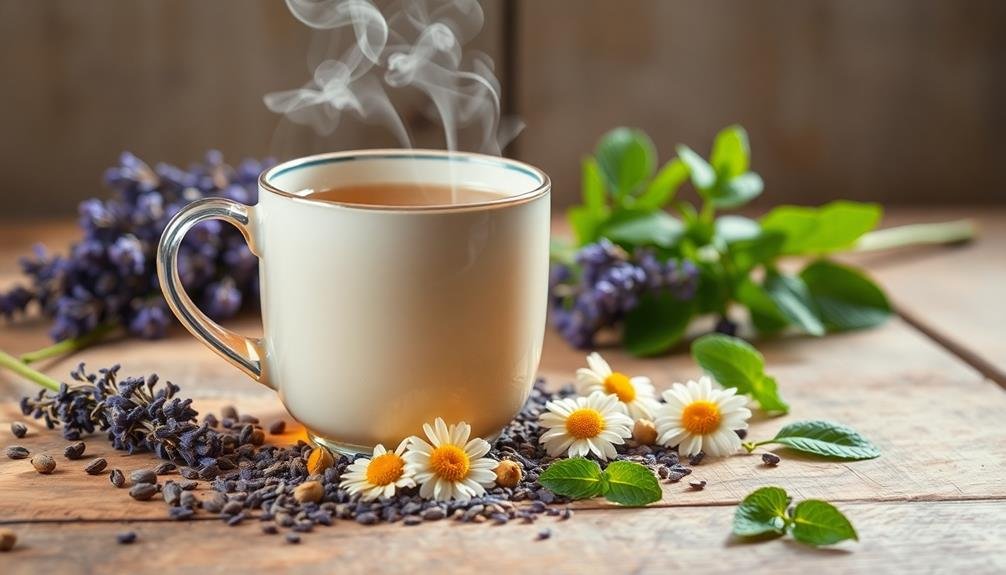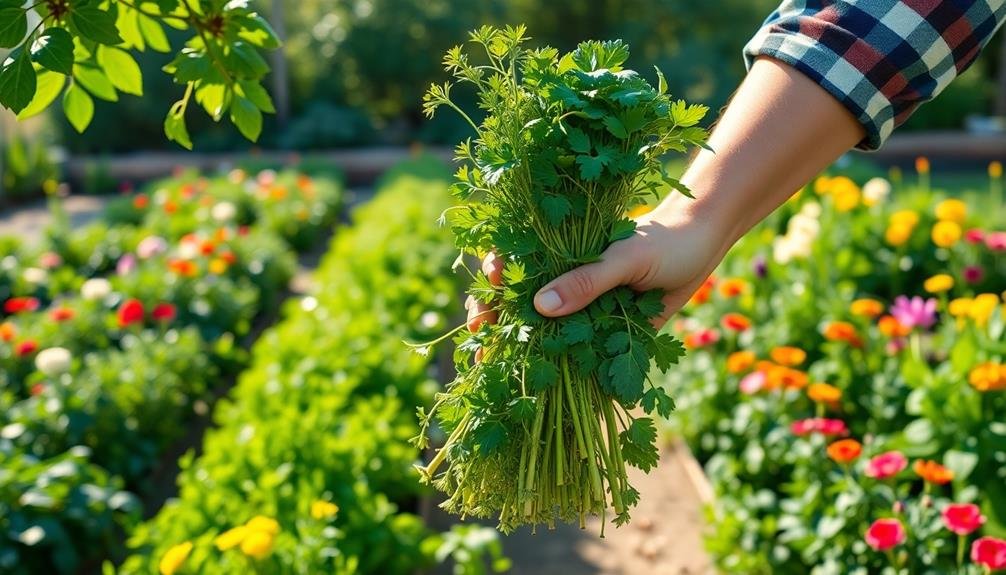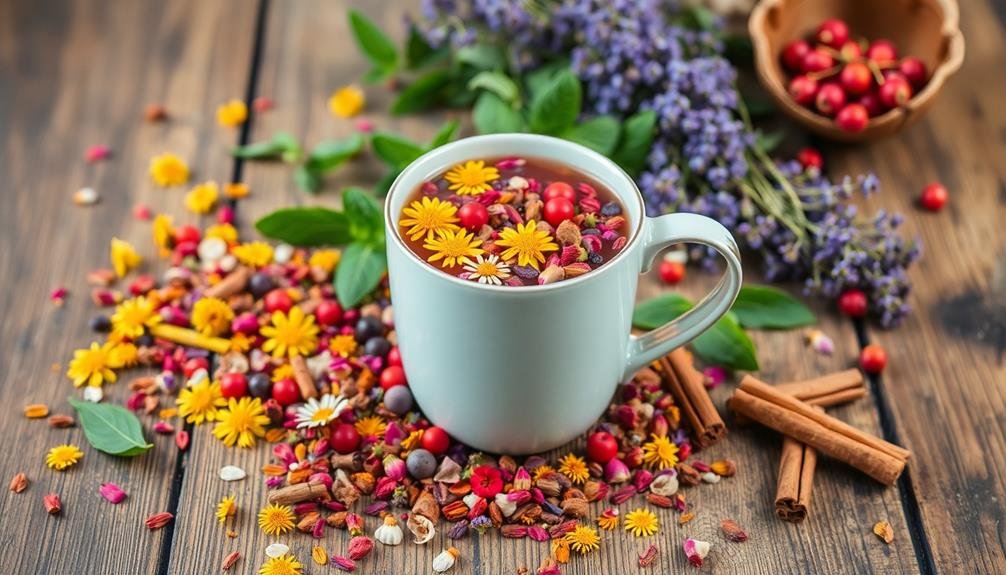Creating custom caffeine-free herbal tea blends offers you a world of benefits. You'll enjoy personalized flavors tailored to your taste preferences while harnessing the health-boosting properties of various herbs. These blends can help you relax, manage stress, and avoid caffeine-related side effects. You'll save money by crafting your own mixes from bulk ingredients, and you can experiment with unique combinations for different seasons or moods. By sourcing herbs locally, you'll support small-scale growers and reduce your environmental impact. With endless possibilities for flavor pairings and therapeutic effects, custom herbal blends open up a fascinating domain of tea exploration.
Health Benefits of Herbal Teas

Herbal teas offer a wide range of health benefits to those who drink them regularly. You'll find that many herbs used in tea blends have antioxidant properties, which can help protect your cells from damage caused by free radicals. These antioxidants may reduce your risk of chronic diseases and boost your immune system.
Some herbal teas, like chamomile and lavender, can promote relaxation and improve sleep quality. They're known for their calming effects, which can help reduce stress and anxiety.
Other blends, such as peppermint and ginger, may aid digestion and relieve nausea or bloating.
You can also find herbal teas that support specific health goals. For example, hibiscus tea may help lower blood pressure, while rosehip tea is rich in vitamin C and can support skin health.
Echinacea tea is often used to boost the immune system and fight off colds.
Personalized Flavor Profiles
You can create your own unique herbal tea blend by tailoring it to your taste preferences.
By combining different herbs and botanicals, you'll discover flavor combinations that perfectly suit your palate.
Experimenting with various ingredients allows you to craft a personalized tea experience that's both exciting and satisfying.
Tailored Taste Preferences
Crafting personalized flavor profiles allows tea enthusiasts to tailor their caffeine-free herbal blends to their unique taste preferences. You can mix and match ingredients to create a blend that perfectly suits your palate. Whether you prefer sweet, spicy, floral, or earthy notes, you're in control of your tea experience.
Consider your favorite flavors and experiment with different combinations. You might discover unexpected pairings that delight your taste buds. Don't be afraid to adjust ratios to find the perfect balance. Remember, creating custom blends is an iterative process, so keep refining until you're satisfied.
Here's a table to inspire your taste preferences:
| Flavor Profile | Herbal Ingredients | Mood | Occasion |
|---|---|---|---|
| Soothing | Chamomile, Lavender | Calm | Bedtime |
| Invigorating | Peppermint, Ginger | Energized | Morning |
| Fruity | Hibiscus, Rosehips | Cheerful | Afternoon |
| Spicy | Cinnamon, Cardamom | Warm | Cold Days |
Unique Flavor Combinations
Exploring unique flavor combinations takes personalized herbal tea blends to the next level. You'll discover exciting new tastes by pairing herbs and botanicals that complement each other in unexpected ways. Start with a base herb like chamomile or peppermint, then add complementary flavors to create a complex and satisfying blend.
Consider combining floral notes with earthy undertones, such as lavender and roasted dandelion root. Or, try mixing fruity hibiscus with spicy ginger for a zesty kick. You can even incorporate unconventional ingredients like rose petals, lemon balm, or holy basil to craft truly distinctive blends.
Don't be afraid to experiment with sweet and savory combinations. A blend of cinnamon, cardamom, and licorice root can offer a delightful dessert-like experience.
Alternatively, mix sage, thyme, and rosemary for a savory, herbal infusion reminiscent of Mediterranean cuisine.
Avoiding Caffeine Side Effects

For those sensitive to caffeine, herbal tea blends offer a soothing alternative without the jitters. By creating custom caffeine-free blends, you're able to enjoy a warm, comforting beverage any time of day without worrying about disrupting your sleep or experiencing other unwanted side effects.
Caffeine can cause various issues for some people, including anxiety, increased heart rate, and digestive problems. With herbal teas, you'll avoid these concerns while still savoring a flavorful drink.
Custom blends allow you to tailor your tea to address specific needs or preferences. You can focus on:
- Relaxation: Incorporate calming herbs like chamomile, lavender, or lemon balm
- Digestive support: Add peppermint, ginger, or fennel to soothe your stomach
- Immune boosting: Include echinacea, elderberry, or rosehips for added health benefits
Seasonal Blending Options
You can create custom herbal tea blends that perfectly match each season's mood and flavors.
For spring and summer, try light and invigorating combinations, while fall harvest blends incorporate warm, earthy notes.
In winter, you'll want to focus on warming infusions that comfort and soothe during the colder months.
Spring and Summer Blends
As the days grow longer and warmer, spring and summer herbal tea blends offer a rejuvenating way to cool down and enjoy the season's bounty.
You'll find that lighter, more invigorating flavors take center stage during these months. Mint, lemongrass, and hibiscus are popular choices for their cooling properties and bright, zesty notes.
When creating your custom spring and summer blends, consider incorporating:
- Floral elements like chamomile, lavender, or rose petals for a delicate, aromatic touch
- Fruit-forward ingredients such as dried berries, citrus peels, or apple pieces for natural sweetness
- Cooling herbs like spearmint, peppermint, or lemon balm to combat the heat
Don't forget to experiment with iced tea versions of your blends. Many herbal combinations taste even better when chilled and served over ice.
You can also add fresh fruits or herbs as garnishes to enhance the visual appeal and flavor profile of your summer sips.
Fall Harvest Combinations
Three key elements define fall harvest herbal tea blends: warmth, comfort, and the rich flavors of autumn. As the leaves change color and temperatures drop, you'll want to create custom teas that embrace the season's essence.
Start with a base of rooibos or honeybush, both caffeine-free and naturally sweet. Add cinnamon, nutmeg, and cloves for a classic fall spice mix that'll warm you from the inside out.
Don't forget to incorporate autumn's bounty. Dried apple pieces bring a touch of sweetness, while rosehips offer a tart counterpoint. You can also experiment with pear, quince, or persimmon for unique fall fruit flavors.
Roasted chicory root adds depth and a coffee-like richness without the caffeine. For an earthier blend, try adding toasted barley or roasted dandelion root. These ingredients provide a robust, grounding flavor perfect for chilly evenings.
Ginger and cardamom will add a spicy kick, while a touch of licorice root can enhance overall sweetness. Remember to balance flavors carefully, ensuring no single ingredient overpowers the others.
With these fall harvest combinations, you'll create comforting, caffeine-free blends that capture autumn's essence in every sip.
Winter Warming Infusions
Winter calls for even heartier blends to combat the cold and darkness. As you create your custom caffeine-free herbal tea blends, focus on warming ingredients that'll nourish your body and soul during the chilly months.
Ginger, cinnamon, and cloves are excellent choices for their thermogenic properties and comforting flavors. Don't forget about immune-boosting herbs like echinacea and elderberry to help ward off seasonal illnesses.
Consider these winter warming infusion ideas:
- Spiced Citrus Comfort: Blend orange peel, cinnamon sticks, star anise, and a touch of vanilla for a fragrant, uplifting brew.
- Ginger Turmeric Tonic: Combine fresh ginger, turmeric root, black pepper, and a hint of honey for an anti-inflammatory powerhouse.
- Festive Chai Delight: Mix rooibos, cardamom, cloves, allspice, and a dash of nutmeg for a caffeine-free twist on traditional chai.
Experiment with different ratios and steep times to find your perfect balance.
You'll discover that crafting your own winter warming infusions not only provides comfort but also allows you to tailor the flavors and health benefits to your specific needs and preferences.
Cost-Effective Tea Making

Making your own herbal tea blends can be surprisingly cost-effective. When you buy herbs and ingredients in bulk, you'll often save money compared to purchasing pre-made herbal tea bags. You can find affordable sources for dried herbs, flowers, and spices at local health food stores, farmers' markets, or online retailers.
By creating your own blends, you're in control of the quality and quantity of ingredients. You can adjust the proportions to suit your taste preferences and avoid paying for unnecessary fillers or artificial flavors. Additionally, you'll reduce packaging waste by reusing your own tea strainers or infusers.
Don't forget to take into account the cost per serving. A small amount of dried herbs can yield multiple cups of tea, making it more economical than single-use tea bags. You can also experiment with using fresh herbs from your garden or windowsill, further reducing costs.
Lastly, creating your own blends allows you to tailor them to your specific health needs or preferences, potentially saving money on specialized wellness teas or supplements. With a little creativity and planning, you'll enjoy delicious, custom herbal teas while keeping your budget in check.
Medicinal Properties and Combinations
Many herbal tea ingredients offer potential medicinal properties, making custom blends an excellent way to support your health naturally.
When creating your own caffeine-free herbal tea combinations, you'll want to reflect on the specific benefits of each ingredient and how they might work together synergistically.
Some popular herbs and their potential medicinal properties include:
- Chamomile: Known for its calming effects, it may help with sleep and anxiety.
- Peppermint: Often used for digestive issues and headache relief.
- Ginger: Praised for its anti-inflammatory and nausea-reducing qualities.
Relaxation and Stress Relief

In light of today's fast-paced world, creating custom herbal tea blends for relaxation and stress relief has become increasingly popular. You'll find that crafting your own caffeine-free blends allows you to tailor the ingredients to your specific needs and preferences.
Chamomile, lavender, and lemon balm are excellent base herbs for calming teas, each offering unique properties to soothe your nerves and promote relaxation.
When combining herbs, consider their complementary effects. For instance, pairing passionflower with valerian root can enhance sleep quality, while adding peppermint to chamomile can alleviate tension headaches. Experiment with ratios to find the perfect balance for your taste buds and desired effects.
Don't overlook the power of aromatherapy in your blends. Herbs like rose petals and jasmine not only add flavor but also provide a calming scent that can further reduce stress.
Additionally, incorporating adaptogenic herbs like ashwagandha or holy basil can help your body better manage stress over time.
Exploring Unique Ingredient Pairings
While relaxation blends are popular, venturing beyond traditional combinations can lead to exciting flavor profiles and unique health benefits.
By exploring unconventional ingredient pairings, you'll discover new favorites and potentially enhance the therapeutic effects of your custom blends.
Consider these unexpected combinations:
- Tulsi and lemongrass: This pairing combines the adaptogenic properties of holy basil with the citrusy zing of lemongrass, creating a revitalizing and stress-relieving blend.
- Hibiscus and ginger: The tart, floral notes of hibiscus complement the warm spiciness of ginger, resulting in a bold, antioxidant-rich tea that supports digestion and heart health.
- Rooibos and cacao nibs: This indulgent mix offers a caffeine-free alternative to chocolate tea, rich in antioxidants and minerals.
Don't be afraid to experiment with contrasting flavors, textures, and aromas.
Combine sweet and savory herbs, or pair cooling ingredients with warming spices.
You might find that licorice root enhances the natural sweetness of chamomile, or that a pinch of black pepper amplifies the benefits of turmeric.
Supporting Local Herb Growers

When creating custom herbal tea blends, you can take your passion a step further by supporting local herb growers. By sourcing ingredients from nearby farms and gardens, you're not only ensuring freshness but also contributing to your local economy.
Many small-scale herb growers offer unique varieties that you won't find in mass-produced teas, allowing you to create truly distinctive blends.
Seek out farmer's markets, community gardens, or local herb farms in your area. You'll often find passionate growers enthusiastic to share their knowledge about cultivation methods and ideal usage of their herbs. This direct connection can inspire new blend ideas and deepen your understanding of the ingredients you're working with.
Supporting local growers also reduces the environmental impact of your tea blends. With shorter transportation distances, you're lowering the carbon footprint of your ingredients.
Plus, many local herb growers use sustainable farming practices, which can align with your values for creating eco-friendly, health-conscious tea blends. By building relationships with these growers, you'll have access to seasonal herbs, allowing you to create limited-edition blends that reflect the changing rhythms of nature in your region.
Frequently Asked Questions
How Long Can I Store My Custom Herbal Tea Blends?
You can store your custom herbal tea blends for up to a year if kept in airtight containers away from light, heat, and moisture. It's best to use them within six months for ideal freshness and flavor.
Are There Any Herbs I Should Avoid Mixing Together?
You should avoid mixing certain herbs together. Some combinations can be harmful or counteract each other's effects. It's best to research each herb's properties and potential interactions before creating your blend. Always consult a healthcare professional for safety.
Can I Use Fresh Herbs Instead of Dried Ones?
You can use fresh herbs, but they're less concentrated than dried ones. You'll need to use more fresh herbs for the same flavor intensity. They also have a shorter shelf life, so it's best to use them quickly.
What Equipment Do I Need to Start Blending My Own Teas?
You'll need basic equipment to start blending teas: a kitchen scale, airtight containers, labels, and a tea infuser. Don't forget mixing bowls, measuring spoons, and a mortar and pestle for crushing ingredients. A notebook's helpful for recording recipes.
How Do I Properly Measure Ingredients for Consistent Flavor in Tea Blends?
You'll need a precise digital scale to measure ingredients by weight. Use consistent ratios for each blend. Keep detailed notes on measurements and proportions. Don't rely on volume measurements, as herb density can vary greatly.
In Summary
You've discovered the joy of crafting custom caffeine-free herbal tea blends. By creating your own, you're opening up a world of health benefits, personalized flavors, and stress-relief options. You're avoiding caffeine's downsides while exploring unique ingredient combinations. You're saving money and supporting local growers. Whether you're blending for medicinal properties or seasonal enjoyment, you're taking control of your tea experience. Keep experimenting and sipping – your perfect blend awaits!





Leave a Reply